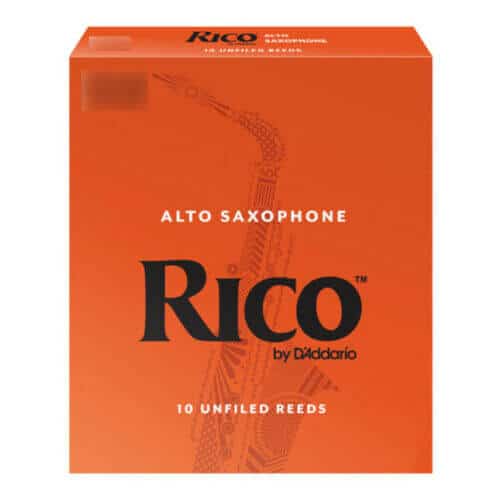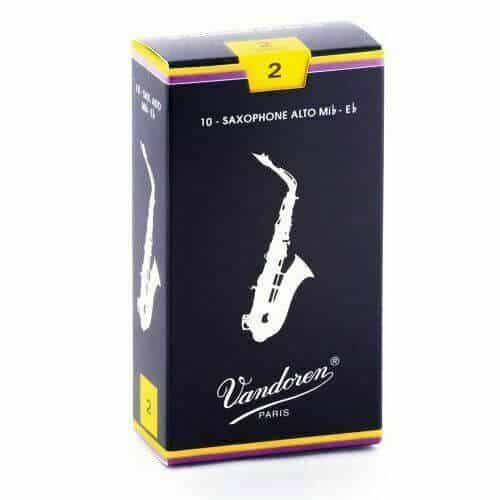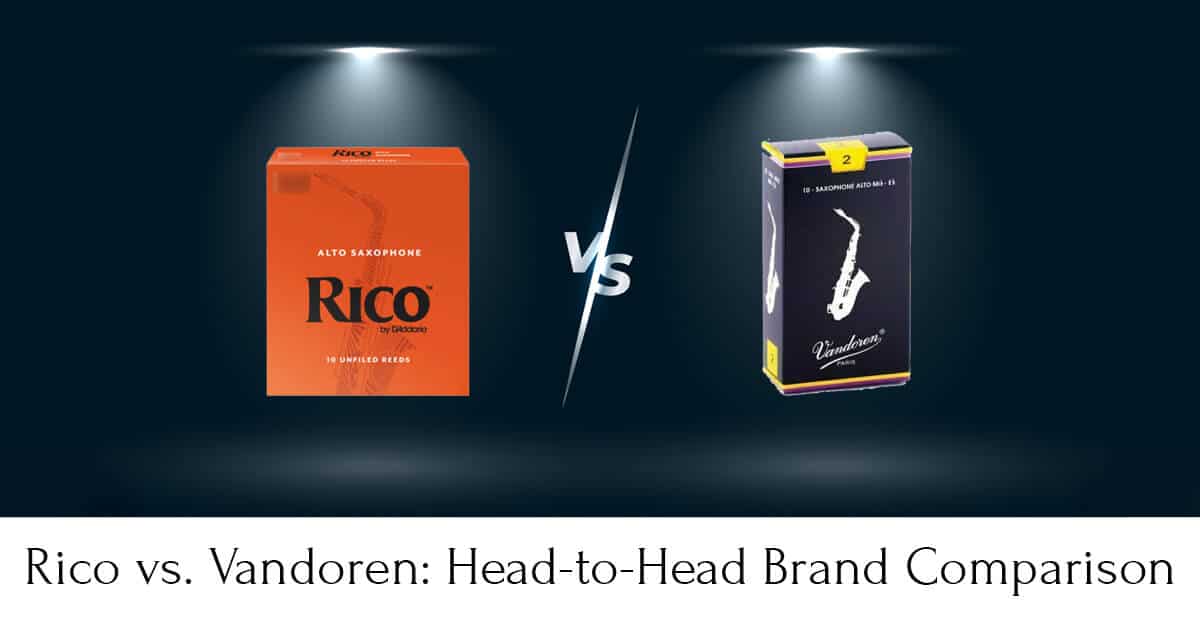If you’re checking out these two popular reed brands, you must be having a hard time deciding between the Rico vs. Vandoren reeds. If that’s the case, you can rest assured that by the end of this article, you’ll have formed a better idea of the similarities and differences to help you reach a final decision.
Table of Contents
Rico vs. Vandoren Reeds: Short Answer
Though both reeds are made by well-established companies and perform excellently, the Rico reeds can’t compare to what French perfection the Vandoren reeds have to offer. They’re more diverse in terms of sizes and strengths, and their intonation is just impossible to exceed in terms of quality.
Here are two well-known Rico and Vandoren Reed Models:
| Image | Product | Details | Price |
|---|---|---|---|
 |
Rico Alto Reeds (Orange Box) | Runner-Up | Check Price |
 |
Vandoren Traditional | Best Overall | Check Price |
The Full Comparison
Type of Saxophone
Rico reeds are available for soprano, alto, tenor, and baritone saxophones if you’re going for the Orange Box, Royal, Plasticover, or Hemke models. The La Voz model excludes the baritone, while the Rico Jazz Select is available for only alto and tenors, though they offer filed and unfiled versions for both sizes. Finally, there’s one that’s exclusive to alto saxophones, which is the Rico Reserve.
On the other hand, the Vandoren reed’s Traditional Blue Box, ZZ, Java Green, and Java Red are all available in the four saxophone sizes. Only the V21 and V12 exclude the baritone size. Not to mention, the Blue Box one is available for sopranino and bass saxophones. So, as you can tell from the available options, Vandoren’s are more diverse.
- Winner: Rico.
Models
Rico reeds come in 7 models: Orange Box, Royal, La Voz, Rico Jazz Select, Plasticover, Hemke, and Rico Reserve. Their sound, intonation, and genre of music are quite different from one to the other, and that’s why you’ll enjoy plenty of diversity when choosing from this lot.
Related: Our full comparison between Rico vs Royal reeds
On the other hand, the Vandoren reeds also come in 7 models: Traditional (Blue Box), V16, ZZ, V12, V21, Java Green, and Java Red. You can read a comparison between the last two in this play-off.
In mere numbers, the Rico reeds give you a few more choices as it has one model more than the Vandoren.
- Winner: Tie.
Strengths
To gather all strengths without making things too complicated, I’ve gathered them in this table that illustrates what strengths and sizes are available for each model.
For the Rico:
| Model | Soprano | Alto | Tenor | Baritone |
| Orange Box | 1.5 to 3.5 | 1.5 to 4 | 1.5 to 3.5 | 1.5 to 3.5 |
| Royal | 1 to 4 | 1 to 4 | 1 to 5 | 1.5 to 4 |
| La Voz | Hard, medium, soft, medium-hard, medium-soft | Hard, medium, soft, medium-hard, medium-soft | Hard, medium, soft, medium-hard, medium-soft | – |
| Jazz Select | – | 2H, 2S, 2M, 3H, 3S, 3M, 4H, 4S, 4M | 2H, 2S, 2M, 3H, 3S, 3M, 4H, 4S, 4M | – |
| Plasticover | 1.5 to 3.5 | 1.5 to 4 | 1.5 to 4 | 1.5 to 4 |
| Hemke | 2 to 3.5 | 2 to 4 | 2 to 4 | 2 to 4 |
| Reserve | – | 2 to 4 | – | – |
For the Vandoren:
| Model | Soprano | Alto | Tenor | Baritone | Sopranino | Bass |
| Traditional (Blue Box) | 1 to 5 | 1 to 5 | 1 to 5 | 2 to 5 | 2, 3 , 4 | 2, 3, 4 |
| V21 | 2.5 to 4.5 | 2.5 to 5 | 2.5 to 4.5 | – | – | – |
| V16 | 2 to 4 | 1.5 to 5 | 1.5 to 5 | 2 to 4 | – | – |
| V12 | 2.5 to 4.5 | 2.5 to 5 | 2 to 4.5 | – | – | – |
| ZZ | 2 to 4 | 1.5 to 4 | 1.5 to 4 | 2 to 4 | – | – |
| Java Green | 2 to 4 | 1 to 4 | 1 to 5 | 2 to 4 | – | – |
| Java Red | 2 to 4 | 1 to 4 | 1 to 5 | 2 to 4 | – | – |
As you can see, the matrix for the Vandoren reeds in terms of strengths that correspond to sizes is much bigger, and that’s why it’ll be easier to find your favorite reed for playing if you opt for Vandoren.
- Winner: Vandoren.
Sound and Performance
Both the Vandoren and Rico reeds are diverse enough in terms of thickness and sizes to suit pretty much any playing purpose.
The Rico ones are easy to use and a bit more flexible as they’re made from cane. Rico uses premium types of cane to ensure consistency. Although they might not be as consistent as synthetic reeds, for cane ones, they’re quite reliable and give you a consistent response.
You can play classical or jazz using the Orange Box, Hemke, Royal, though the latter two are French filed to give you even faster response, clear tones, and more flexibility.
For dedicated jazz players, you can opt for La Voz, and of course, the Rico Jazz Select that has a longer vamp and well-defined heart for the ultimate top-notch projection. The Plasticover would suit pop, funk work, and rock. The Plasticover reeds come with plastic coating in order to reduce deterioration due to the climate and moisture, which extends the reed’s lifespan.
On the other hand, the Traditional Blue Box Vandoren suits pretty much any genre you’d like to play, and it’s the most flexible in terms of sound, sizes, and strengths.
Related: Vandoren V21 Alto Reeds Full Review
If you’re more into jazz, you might want to check out the Vandoren Java Green, Java Red, ZZ, and V16 for American Jazz. Though the Vandoren reeds are synthetic instead of cane-made, they give you enough flexibility and elasticity to hit your tones perfectly. The Java Green and V16 are both American unfiled, the Blue Box is French filed, while the Java Red is filed.
The V12 actually came to be thanks to its clarinet counterpart that was a huge success. These ones come with thick heels and the palettes on which they’re cut are longer, giving them richer sounds and enabling them to produce more vibrations. If you’re looking for more body to your attack and a darker tone, the V12 ones are your go-to Vandoren reeds.
Despite the fact that the Rico reeds seem more diverse, the Vandoren ones have better intonation and are less buzzy, making them a better option for controlling your tones and pitches. They’re not only the best alto sax reeds but w(Saxophones)ork well across the entire size spectrum.
- Winner: Vandoren.
Conclusion
Obviously, between Rico vs. Vandoren, the latter takes the cake in plenty of aspects. Not to mention, the French have established themselves in the realm of saxophones with the one and only Selmer Paris saxophones, so it’s not surprising that they’re just as excellent when it comes to making reeds.

